What’s in Season for July?
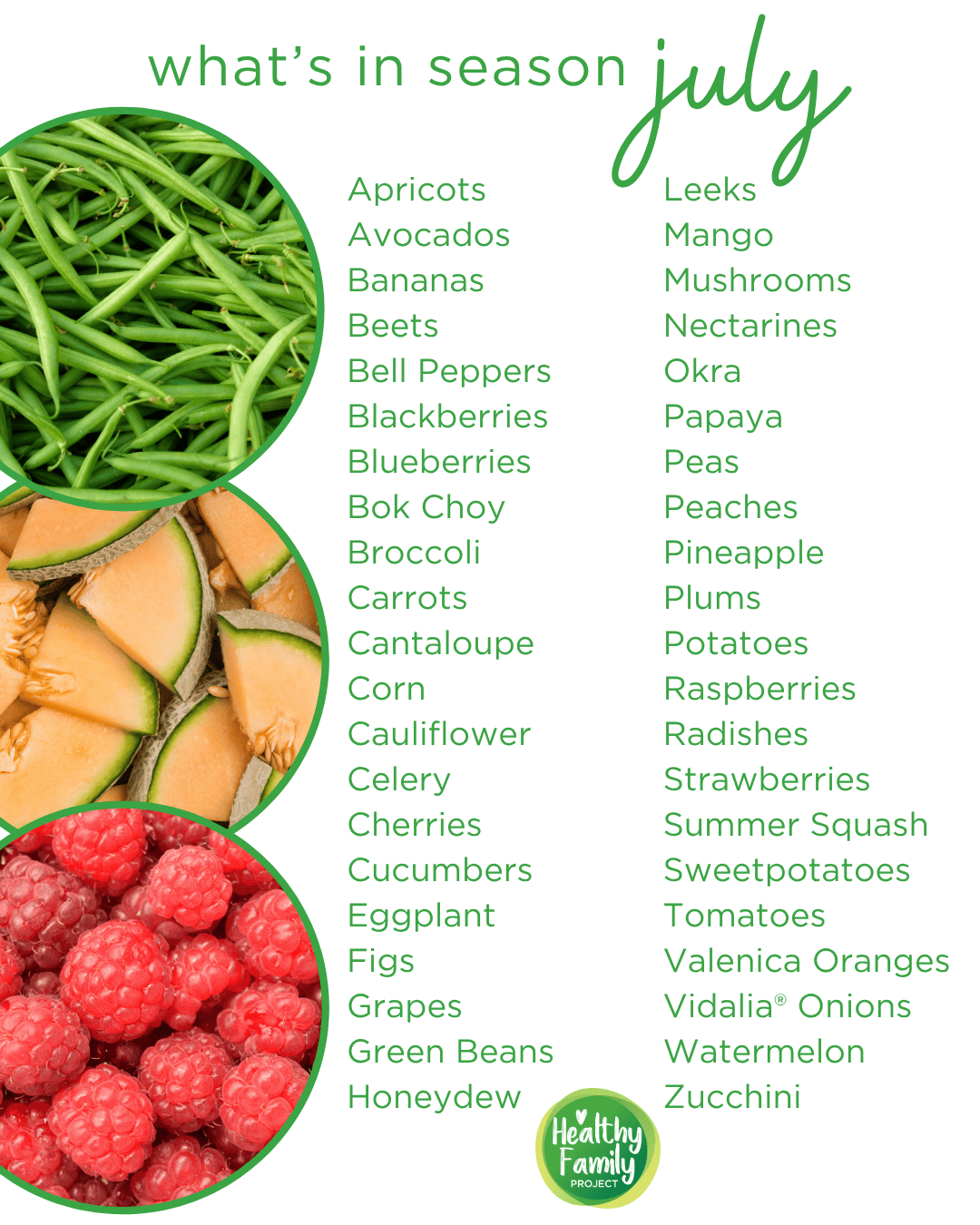
Happy July! July is peak summer – cookouts on the weekends, family camping trips, water activities and more. Don’t forget to pack some fresh fruits and veggies to fuel you up and keep you hydrated on hot days. While you’re at the grocery store, make sure to pick up some of these in-season fruits and veggies.
Knowing what fresh produce items are in season when you head to the grocery store can not only save you money but also means that you’ll be enjoying fruits and veggies at their peak!
Healthy eating doesn’t have to be expensive. Planning meals around in-season fresh produce is one of the easiest ways to save on groceries. Click on each of the listed items for tips on how to pick, prepare and store these seasonal fruits and veggies, along with tasty recipe ideas.
What’s in Season for July:

Avocados
Avocado lovers can rejoice – this favorite food is available year-round! Whether you’re topping toast, swapping in for a healthier dessert (hello, Dark Chocolate Avocado Brownies!) or whipping up a bowl of guacamole, you can pick up avocados in stores all year.

Bananas
This favorite fruit is in season year-round making it easy to eat as a snack or add to smoothies, muffins, pancakes and turn into “nice” cream. Fun fact: the average American eats 28 pounds of bananas per year!

Beets
Beets get a bad rep due to their earthy taste, but roasting them brings out their natural sweetness and makes them perfect for adding to salads, blending into smoothies and more.

Bell Peppers
Peak season for bell peppers is July through September, but can usually be found year round in stores. Bell peppers are an excellent source of Vitamin A and C and a good source of Vitamin E and Vitamin B6. Store bell peppers unwashed in a plastic bag in the crisper drawer of your refrigerator for up to 4-5 days. Great for snacking, stuffing and a wide variety of dishes.

Blackberries
Blackberries are in peak season from June to August, so grab them while their fresh and on sale! Did you know blackberries have one of the highest antioxidant contents of any food? Enjoy them in a smoothie bowl, summer fruit salad, or as a fun dessert!

Blueberries
While blueberries can be found year-round in most regions, April to September is peak season. There are lots of great reasons to reach for blueberries. Did you know blueberries contain antioxidants that can improve vision, motor skills and reverse short-term memory loss associated with age-related diseases? Try them in this Easy Fruit Salsa, delicious baked oatmeal, in muffins, smoothies or even salads.

Bok Choy
Bok choy is a type of Chinese cabbage with a mild flavor that’s delicious both raw and cooked. While bok choy is usually available year-round, it’s at its peak in colder months. Try it in a stir-fry, salad, soup, or this homemade Instant Pot Chicken Ramen!

Broccoli
This veggie is full of vitamins and nutrients your body needs. Fresh broccoli is available year-round and can be added to almost any meal. Chop and add to a salad or turn into a broccoli slaw, steam or roast for an easy side dish, or toss into pasta salads, stir-fry, cornbread muffins and more.

Cantaloupe
This sweet melon is ready to eat this summer! Cantaloupes are an excellent source of Vitamin A and Vitamin C, and are also high in fiber. Enjoy sliced or in a fruit salad.

Carrots
Carrots aren’t just for Bugs Bunny! This kid-favorite veggie can simply be served with a side of ranch for dipping, roasted (bringing out a natural sweetness), steamed, or shredded and added to muffins, soups, mac n cheese, meatballs and more.

Cauliflower
Talk about a comeback veggie! Cauliflower is taking the culinary world by storm and popping up in everything from pizza crust to fried rice. This versatile veggie can be used to make pesto, added to mashed potatoes for a lighter dish, turned into savory waffles, or used to replace rice in classic casseroles.

Celery
This crunchy veggie is best known by kids as the base of Ants on a Log, but can also be used in many different ways to add flavor and texture to dishes. Chop and add to a potato salad, use as a base for soups, add crunch to salads and more.

Cherries
Does anyone else wait all year for cherries to be in season? Cherry season starts in May, although depending on where you live you might not see a lot of fresh cherries until June. Make sure to stock up and get your fill during the late spring and summer months, they won’t be back in stores until next year! Try them grilled, on a pizza, baked in oatmeal or as dessert!

Corn
Grab your fresh corn on the cob! Late spring and summer mean corn on the cob is in abundance at your local grocery store. Shrimp boil anyone? We also can’t forget a good grilled corn on the cob recipe!

Cucumbers
While available year-round, summer is when cucumbers really shine. Choose cucumbers with firm, dark green skin. Avoid wrinkles or spongy spots. Slice them up for a salad, easy snacking with a Tzatziki dip, or to make homemade pickles.

Eggplant
It’s peak season for eggplant – perfect time to grab some for the grill! Look for firm, glossy eggplants that feel heavy for their size. They should be free to wrinkled skin, soft spots or brown patches. Throw some on the grill, in an easy pasta dish or use in place of pasta for this rollatini!

Grapes
Grapes are a perfect treat for warmer months! They’re light, refreshing and easily packed for picnics, summer lunches and more. Grapes are also an excellent source of Vitamin C, potassium and Vitamin K. Check out some of our favorite grape recipes!

Green Beans
Green beans are a family favorite and for good reason! Green beans are an excellent source of fiber and Vitamin A. They’re also a good source of folates, Vitamin B6, thiamin, Vitamin C. Store unwashed green beans in a plastic bag or container in the crisper drawer of your refrigerator for up to 4 days before enjoying. Add them to your favorite sheet pan dinner, soups, and more.

Greens
Fresh greens like kale, spinach, lettuce, and many others are the basis for so many tasty recipes like salads or for pumping up nutrition in smoothies, soups, casseroles, pasta dishes and more.
Leeks
Leeks have a mild, onion-like taste and are related to onions, garlic, shallots and chives. Make sure to thoroughly rinse leeks and pay fry with a paper towel before consuming. You can roast them, add them to a salad, use as a garnish for soups, add to casseroles and much more.

Lemons & Limes
Both lemons and limes are in season year-round and are great for adding flavor to dishes. Juice and use for a fresh, homemade salad dressing, use season chicken, fish or veggies, or combine to add zing to these Baked Avocado Fries!

Mango
Look for fresh mangos that give slightly when squeezed gently, these ones will be ripe and ready to eat! Keep unripe mango stored on the counter until ripe. Blend into these smoothie popsicles, add to a tangy stir fry, or enjoy in a fresh salad.

Mushrooms
Did you know Mushrooms are the only natural food source of Vitamin D? Mushrooms are so versatile, you can blend and add to tacos or burgers, use as a base for these Pizza Stuffed Mushrooms, or add to easy weeknight dinners like this Asian Chicken Stir Fry.

Okra
We’re hitting the end of okra season, so grab them while you can! To avoid slimy okra when cooking, soak them in vinegar for 30 minutes before cooking.

Papaya
Papaya may seem like an exotic fruit, but it’s a common fruit found throughout the year in most stores. Don’t be intimidated by getting one. They’re easy to eat! Just cut in half, scoop out the seeds, then scoop out the fruit and enjoy!

Peaches
Another fruit we can get enough of this time of year is peaches! Be careful not to squeeze peaches when selecting them at the store. They bruise easily! Look for ones that are soft to the touch but not mushy. Store firm, unripened peaches on the counter until ripe, or place ripe peaches in the refrigerator to keep them fresh longer. Check out some of our favorite ways to enjoy peaches.

Peas
While you can find frozen peas year-round, there’s nothing like fresh peas, which are in season during spring and early summer months. When buying peas, look for medium-sized pods with smaller peas for sweeter peas. Try them in this Quick & Easy Tuna Pasta Salad for the perfect spring dish!

Pineapple
While pineapples are available year-round, the peak season is March through July. This sweet fruit is full of Vitamin C, manganese, copper, and folate! When picking a pineapple, make sure to give them a sniff – you should smell the sweet, distinctive smell of the pineapple. Enjoy in a fruit salad, smoothie bowl, or as these fun fruit breakfast skewers!

Potatoes
With more than 600 types of potatoes sold in the US, the possibilities are endless. While potatoes sometimes get a bad rep, skin-on potatoes are full of Vitamin C, potassium, and Vitamin B6. Whether you’re looking for healthy ways to top a baked potato, different ways to season roasted potatoes, or just healthy potato recipes, we’ve got you covered.

Raspberries
We can’t get enough fresh berries in the summer and raspberries are no exception! Raspberries are high in fiber and Vitamin C, so eat up! Enjoy these individual Raspberry & Peach Crisps for a summer treat, top of your English muffins with them, or add to your pancakes.

Stone Fruit
We already covered off on cherries and peaches, but other varieties of stone fruit are also in season, including apricots, nectarines, plums and pluots.

Strawberries
Florida strawberry season is in full swing! This favorite fruit has endless possibilities beyond just snacking. Blend into muffins, make the perfect smoothie, add to a delicious fruit salsa or top off your pancakes.

Summer Squash
Summer squash is available year-round in some regions, with peak season being June to August. Summer squash is a rich source of Vitamin A, Vitamin C, magnesium, fiber, folate, riboflavin, phosphorus, potassium, and Vitamin B6. Shred into cole slaw, add to skewers for the grill, or sautee for a quick veggie side.

Tomatoes
There’s something about a fresh tomato in the summertime. Ripe, juicy and full of flavor! Look for plump, heavy tomatoes with smooth skins. They should be free of bruises, blemishes, or deep cracks, although fine cracks at the stem ends of ripe tomatoes do not affect flavor. There are so many ways to enjoy them – in a pasta dish, salsa, salad and more.

Vidalia® Onions
Vidalia Onions are in season! Onions are a staple in our kitchen and we use them in multiple meals each week. While I still haven’t mastered cutting onions without crying, we can’t deny they’re essential to adding flavor to everything from soups and chili to meatballs and breakfast burritos.

Watermelon
Get ready to hydrate with fresh watermelon! Watermelon is 92% water so enjoy it on a hot day. Choose a firm, symmetrical watermelon that’s heavy for its size and free of bruises, soft spots, moldy patches and cracks. The underside of the watermelon should have a creamy yellow spot. This is from where the watermelon sat on the ground and ripened. Enjoy in a fresh salsa over grilled chicken, in a smoothie, fruit salad, or as a popsicle!

Zucchini
Rich in fiber, Vitamin A and Vitamin C, zucchini helps lower cholesterol, guards against asthma and strengthens teeth and bones. Store zucchini unwashed in a perforated plastic bag in the crisper drawer of your refrigerator for up to 5 days. Enjoy on a pizza, in muffins, as “fries”, or on the grill.

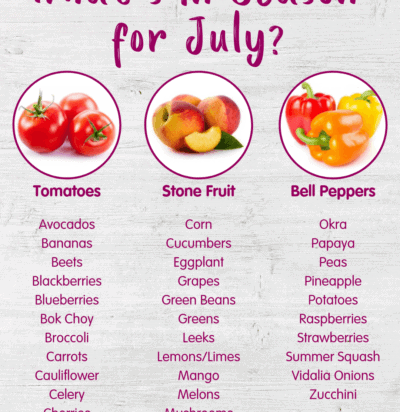
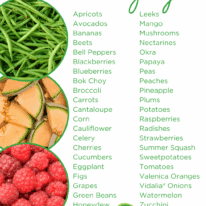







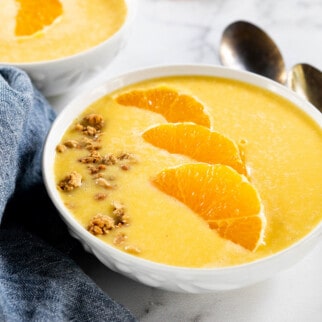
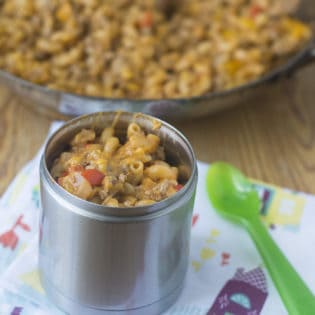

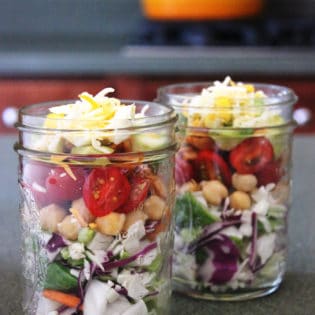

It’s helpful that you list the nutritional values to these. I live getting my vitamins from foods but it’s hard to know what contains each vitamin. I also love that you include how to prepare and cook with these. Great article!!
Hello,
I need guidance of getting thru my day eating enough protein without gluten, wheat, or dairy
Hi Dawn,
There are lots of great ways to meet your protein intake without dairy or gluten. Lean proteins like chicken, turkey and fish offer a great source of protein without gluten or dairy. Eggs, lean beef and pork also offer a great source of protein. Likewise, there are plenty of great plant-based proteins like beans, legumes, quinoa, tofu, nuts, seeds, chickpeas, tempeh, lentils and so much more that are naturally gluten and dairy free.
It’s recommended that adult women get 46 grams of protein per day. A 3oz portion of cooked chicken breast offer 21g, which is almost halfway there!